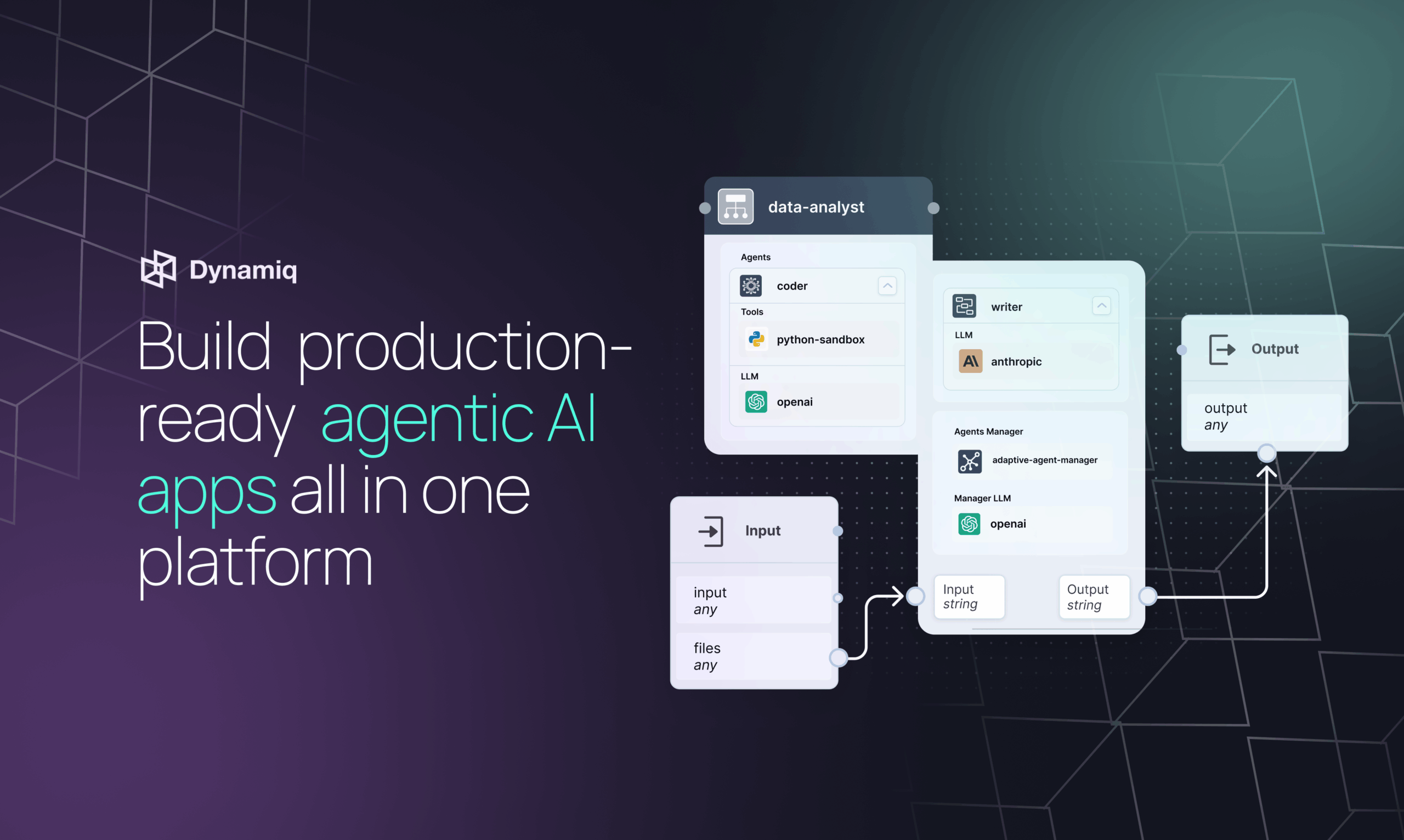Table of Contents
Overview
In today’s fast-moving AI landscape, launching intelligent agents can still take months of development and complex infrastructure setup. Dynamiq is a low-code enterprise platform that can reduce prototyping time to mere hours, with proof-of-concepts often ready in four to six weeks. It provides a unified studio for designing, testing, and deploying agentic AI applications while handling backend infrastructure, scaling, and security on behalf of the user.
Key Features
- Low-code AI agent builder: Design and customize AI agents using drag-and-drop templates and optional Python scripts, dramatically accelerating development.
- Built-in RAG integration: Seamlessly connect agents to your data sources via native Retrieval-Augmented Generation pipelines so that responses stay grounded in up-to-date business information.
- Observability and monitoring tools: Track agent decisions, API calls, and performance metrics in real time through dashboards and logs, making debugging transparent and efficient.
- Enterprise-grade orchestration: Coordinate multi-agent workflows with built-in retry logic, parallel execution, and error handling to support complex automation at scale.
- Chat UI integration: Deploy ready-to-use conversational interfaces or expose agents via RESTful APIs to embed AI assistants in customer support and internal chat systems without extra frontend work.
- Real-time testing environment: Instantly validate workflow changes in a sandbox; for production scenarios, a staging environment is recommended before live deployment.
- API integrations for business workflows: Embed agents directly into ERP, CRM, ticketing, and other systems through connectors, webhooks, and RESTful endpoints.
- Security and compliance guardrails: Enforce role-based access control, input/output validation, and audit logging to meet industry standards in regulated environments.
- Flexible deployment options: Choose on-premises, cloud, or hybrid hosting to align with data sovereignty and infrastructure policies.
How It Works
Begin by mapping agent roles, tasks, and conversational flows in the visual studio, where each node represents an LLM call, data lookup, or business action. The platform automatically provisions a RAG pipeline to index and query your documents, ensuring that agents consult the most accurate information. With a single click, agents can be deployed to your chosen environment: Dynamiq takes care of containerization, scaling, load balancing, and security settings. While in production, the observability suite captures every interaction, making it easy to monitor, debug, and optimize agent behavior. Advanced teams can also fine-tune open-source LLMs on proprietary data directly within the platform to improve domain specificity and performance.
Use Cases
- Enterprise workflow automation: Chain AI agents to handle tasks like invoice processing, data entry, and report generation without manual intervention.
- AI-powered customer support: Deploy chatagents that answer FAQs, triage tickets, and escalate complex cases to human staff as needed.
- Internal knowledge assistants: Provide employees with an AI-driven interface to search policies, technical documents, and project archives.
- Business data analysis: Automate data ingestion, transformation, and insight generation so analysts can focus on strategic decision-making.
- Document processing agents: Extract, classify, and process information from contracts, forms, and emails to reduce manual workload.
- Operational task orchestration: Coordinate cross-departmental tasks—such as onboarding or compliance checks—by sequencing agent workflows across systems.
Pros \& Cons
Advantages
- Rapid prototyping and deployment without manual infrastructure setup accelerate time-to-market.
- Real-time observability delivers clear visibility into agent behavior, simplifying troubleshooting.
- Full-stack orchestration supports end-to-end agent lifecycle management, from design to monitoring.
- Built-in security, compliance features, and audit logs meet enterprise governance requirements.
Disadvantages
- Complex custom workflows and advanced fine-tuning may require developer expertise in AI and Python.
- Enterprise-level pricing may be a barrier for small teams or early-stage startups with limited budgets.
- While core integrations are extensive, certain legacy or niche systems may need custom connectors.
How Does It Compare?
- LangChain Hub: Offers an open-source ecosystem and modular building blocks but relies on more hands-on coding and separate deployment tools.
- Pipedream AI: Excels at general automation and API orchestration but requires manual setup for RAG pipelines and lacks a native observability layer for AI workflows.
- CrewAI: Specializes in multi-agent collaboration with role-based architectures for complex research tasks, whereas Dynamiq focuses on streamlined business process automation with integrated RAG and compliance guardrails.
Final Thoughts
By combining a low-code visual studio, native RAG, and enterprise-grade orchestration in a single platform, Dynamiq empowers organizations to deliver AI-driven workflows in hours rather than weeks or months. With built-in observability, security guardrails, and flexible deployment options, it offers a robust foundation for enterprises seeking to automate real-world processes at scale.
